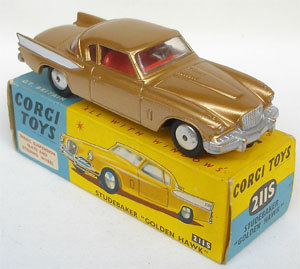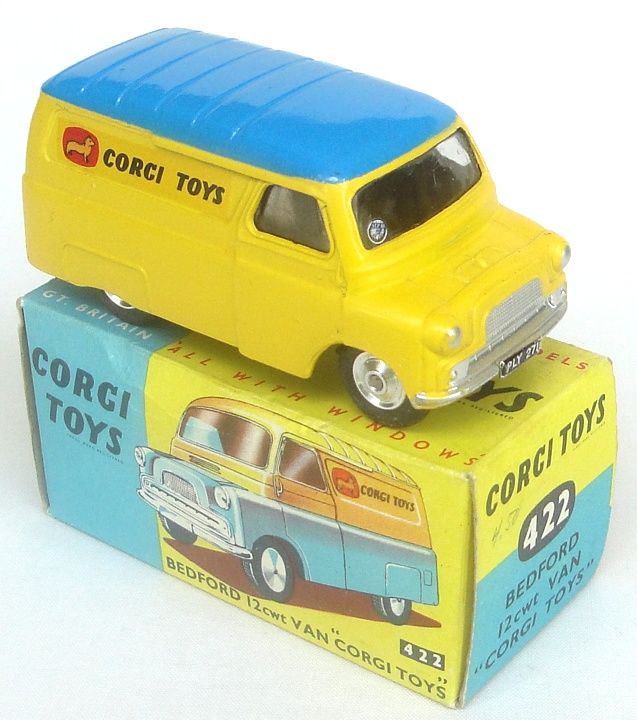Some time ago I looked at the possible distribution of wheel types during a production period for Corgis. In particular, I am interested in establishing the comparative scarcity of one or another type for a group of models issued between early 1960 and early 1961.
These will have all been first sent out to the shops with smooth fixed wheels with later editions fitted with a shaped, but still fixed, wheel. One or two long-running models will also have had free-spinning wheels fitted at a later point.
In a not particularly scientific survey, the chart below shows the distribution of wheel types that I found on models for sale or sold on a few web sites.
The key S = free spinning, F = smooth fixed, F2 = smooth shaped, F3= cast fixed (as on 218).
The models which did not have a great period of production after 1961 show a marked scarcity of the shaped wheel variety - in fact I was unable to see any for the 421 Bedford Evening Standard model.
For those that had a distinctly longer life then the fixed shaped wheel still seems comparatively scarce and similar in proportion to the free spinning wheel that followed. The 218 Aston Martin is a good example where one might have thought that the cast 'spoke effect' type was scarce but, in fact, it seems quite plentiful and it may be the fixed shaped type that is the one to look out for.
One surprise for me is the lack of any 210S Citroen models with free spinning wheels. I have two in stock but that's all I noticed anywhere. They are also both the variety with fog lamps in the casting. I find it hard to believe that the change of upper body casting corresponded to a change of wheel as I had regarded the fog lamps version to have been issued after the 323 Monte Carlo edition had become dated, the holes for jewels being filled with mazak instead. By that time one would have expected the 210S to have been fitted for some years with free spinning wheels.
I should mention that the 211S Studebaker figures are split between two models - the June 1960 issue with silver or gold-plated finish and a later issue with gold paint.
The Jaguar Fire Service model was the last model with normal-size wheels to be issued with the smooth fixed type, which is why I stopped at March 1961. Prior to January 1960, though, there are several models which also continued in production for many years and these I shall have another look at in a while. Generally, though, for the earlier models we know that the fixed shaped wheels are less common or really scarce in some instances and there are likely to be fewer surprises in that data.
For now the search is on for some Bedfords with shaped wheels, a Studebaker painted gold with smooth wheels and the errant Citroen with free spinning wheels!
Saturday, 22 February 2020
Saturday, 1 February 2020
Corgi Toys @ 60: A Mini, Planks and Cement Bags
It's February 1960 and here's the very first Mini from Corgi. This is the Morris Mini-Minor. (The Austin Seven comes next year.)
First appearing in what I call baby blue, with a cream or red interior. That cream interior, however, seems to be dropped pretty soon so the red one is by far the most common amongst the early editions. Over the years this little car will go through many variations. The most obvious will be the colours as this will appear in a wide range of blues, each seeming to have either a red or (the later and quite different to the cream) lemon interior, as well as deep maroon in 1968. Then there'll be the wheels, changing to fixed shaped, then free spinning shaped, then cast with a louvre effect and very late in its life with Whizzwheels in shades of mid-blue and dark blue, some metallic, and orange coloured models, renumbered 204.
It will also have two distinct body castings and several different bases. I have tried to describe these and illustrate some in my earlier article which you can find at this link.
The other issues this month were the first two Corgi Cargoes. 1485 was a block of planks and 1488 was a block of cement bags.
These would fit neatly on either a platform lorry or the trailers and looked quite smart. Until then we had to pile whatever we had lying around. I found matches made good planks but they kept falling off. Bayko bits and pieces were the best loads and I had plenty of that - the doors fitted nicely and were probably a bit safer than the matches although I don't recall any of my friends burning their houses down with the Swan Vestas that we all had.
Subscribe to:
Posts (Atom)











